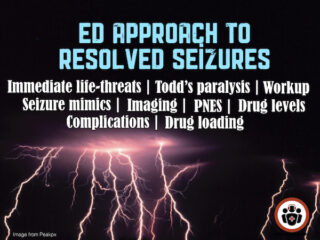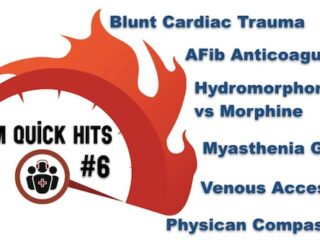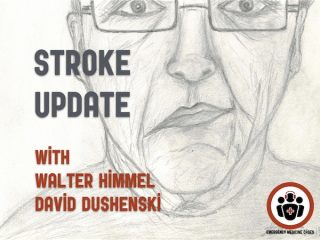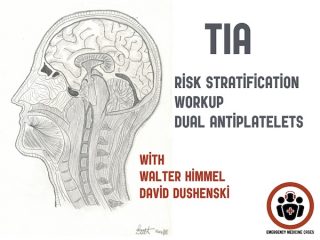Neurology
Ep 132 Emergency Approach to Resolved Seizures
What is the essential list of immediate life threats with specific antidotes that we must know for the ED patient with a seizure? What are the key elements for distinguishing a true seizure from syncope? From Psychogenic Non-Epileptic Seizure (PNES)? From TIA? From migraine? How do you distinguish Todd's Paralysis from TIA or stroke? What are indications for lactate and troponins in patients who present with a seizure? Do all patients with first time unprovoked seizures require anti-seizure medication in the ED? What is the preferred anti-seizure medication and route for ED loading for the patient with a first time seizure? Which patients who present with seizure require a CT head in the ED? What are indications and ideal timing for EEG for patient who present to the ED with seizure? and many more...
EM Quick Hits 7 Approach to Status Epilepticus, Codeine Interactions, Anticoagulation in Malignancy, Atrial Fibrillation Rate vs Rhythm Control, Peripheral Vasopressors, Motivational Interviewing
Anand Swaminathan on a simple approach to status epilepticus, David Juurlink on codeine and tramadol interactions: nasty drugs with nastier drug interactions, Brit Long on DOACS in patients with malignancy: which patient's with cancer can be safely prescribed DOACs? Ian Stiell on atrial fibrillation rate vs rhythm control controversy, Justin Morgenstern on peripheral vasopressors: safe or unsafe? Michelle Klaiman, Taryn Lloyd on motivational interviewing that makes a difference to patient's lives...
EM Quick Hits 6 Blunt Cardiac Trauma, Atrial Fibrillation Anticoagulation, Hydromorphone vs Morphine, Myasthenia Gravis, Venous Access
In this EM Quick Hits episode: Andrew Petrosoniak on diagnosis and risk stratification of blunt cardiac trauma, Clare Atzema on latest guidelines for anticoagulation in atrial fibrillation, Maria Ivankovic on hydromorphone vs morphine for acute pain, Brit Long on clinical pearls in the diagnosis of myasthenia gravis, Anand Swaminathan on venous access tips and tricks, and bonus material from EM Cases Course June 2018 with Walter Himmel and Barbara Tatham on Physician Compassion and tools to prevent burnout...
Ep 120 ED Stroke Management in the Age of Endovascular Therapy
In this EM Cases main episode podcast, a follow up to our episode on TIA released in November 2018 with Walter Himmel and David Dushenski, we’ll try to simplify the confusing time-based and brain tissue-based options for stroke management. We’ll answer the questions that have been plaguing us for a while now: Which patients are eligible for endovascular therapies? Which patients are the ones who’ll benefit from these therapies and how do we make that happen in our different practice environments? Which patients should be considered for lytic therapy? Which patients should be considered for both lytic and endovascular therapy? and many more...
Ep 117 TIA Update – Risk Stratification, Workup and Dual Antiplatelet Therapy
Much has changed in recent years when it comes to TIA risk stratification, workup and antiplatelet therapy. In this podcast we use the overarching theme of timing to elucidate how to distinguish true TIA from the common TIA mimics, the importance of timing in the workup of TIA, why the duration of therapy with dual antiplatelet therapy and timing of starting anticoagulation in patient with atrial fibrillation, contributes to the difference between preventing catastrophic strokes and causing intracranial hemorrhage...
CritCases 10 Hyponatremia Associated Seizures
In this EM Cases CritCases blog - a collaboration between STARS Air Ambulance Service, Mike Betzner and EM Cases, a middle aged woman presents to a rural ED with headache and vomiting, normal vital signs with subsequent status epilepticus and serum sodium of 110 mmol/L. What management recommendations would you make to the rural ED physician, the transport team and in your ED with regards to treatment of seizures, safe correction of hyponatremia, airway management, search for underlying cause and prevention of Osmotic Demyelenation Syndrome?







